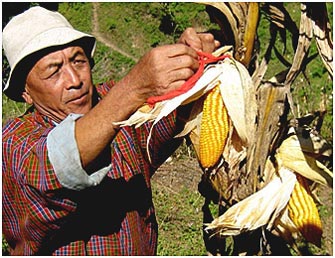 Maize is one of the major staples in Bhutan and is cultivated by about 70 percent of households throughout the country. Poor farmers sustain their families by consuming maize as a staple food, using it as animal feed, and selling it for further income. Thus, the 2007 outbreak of Gray Leaf Spot (GLS), a new disease caused by Cercospora zeae-maydis, posed a major challenge to the Bhutanese maize program and maize farmers, many of whom lost over 70 percent of their production.
Maize is one of the major staples in Bhutan and is cultivated by about 70 percent of households throughout the country. Poor farmers sustain their families by consuming maize as a staple food, using it as animal feed, and selling it for further income. Thus, the 2007 outbreak of Gray Leaf Spot (GLS), a new disease caused by Cercospora zeae-maydis, posed a major challenge to the Bhutanese maize program and maize farmers, many of whom lost over 70 percent of their production.
To contain the disease, the National Maize Program collaborated with the CIMMYT South Asia Regional Office in Nepal to develop or identify new GLS-tolerant maize varieties able to adapt to the high-altitude, rainfed, mountainous, maizegrowing highlands of Bhutan. Over 100 GLS-tolerant maize varieties were introduced from CIMMYT Colombia, Zimbabwe, Mexico, and Nepal, and screened at hot-spot sites where GLS occurs naturally and in abundance. Initial selections of the disease tolerant lines were made at Chaskar (1,960 masl), Mongar, by a maize research team based at the Renewal Natural Resources Research and Development Center, Wengkhar, Mongar district.
Several years of multi-location, nationally-coordinated evaluation resulted in provisional release of two entries from CIMMYT Colombia: ICAV305 and S03TLYQAB05. In 2011, over 2.6 tons of seeds were supplied to farmers affected by GLS for frontline demonstration and seed replacement. After a successful large-scale demonstration, ICAV305 and S03TLYQAB05 were recommended for formal release to the Technology Release Committee of the Ministry of Agriculture and Forests, which was endorsed on 22 June 2012. The names of these two varieties are Shafangma Ashom and Chaskarpa.
The new varieties have shown 10 percent yield advantage and much higher tolerance to GLS than traditional varieties. The yield is comparable to the popular improved variety Yangtsipa (Suwan 1) grown in lower elevations. The new varieties are recommended particularly for GLS-affected areas above 1,500 masl, and for subtropical maize production zones at 600-700 masl. Both varieties have yellow flint grains, which are highly preferred by maize farmers, and are open-pollinated. Shafangma Ashom is a Quality Protein Maize (QPM), which is more nutritious than the traditional maize varieties. This is the first QPM variety released in Bhutan, and it is expected to contribute immensely to the nutritional requirements of the local population.
 The replacement of seeds has been facilitated through Community Based Seed Producers (CBSP) groups. In 2011 and 2012, over eight tons of seed was supplied to GLS-affected farmers in 10 districts. The average yield recorded under farmers management was 3.73 t/ ha for S03TLYQAB05, and 4.43 t/ ha for ICAV305. Production of basic and foundation seeds has started at research farms and will serve as seed source for the CBSP groups. By 2013, the National Maize Program aims to replace 80 percent of the seeds for GLSaffected farmers cultivating maize above 1,500 masl. The program cooperates with the National Seed Center and CBSP groups to achieve higher efficiency in seed replacement.
The replacement of seeds has been facilitated through Community Based Seed Producers (CBSP) groups. In 2011 and 2012, over eight tons of seed was supplied to GLS-affected farmers in 10 districts. The average yield recorded under farmers management was 3.73 t/ ha for S03TLYQAB05, and 4.43 t/ ha for ICAV305. Production of basic and foundation seeds has started at research farms and will serve as seed source for the CBSP groups. By 2013, the National Maize Program aims to replace 80 percent of the seeds for GLSaffected farmers cultivating maize above 1,500 masl. The program cooperates with the National Seed Center and CBSP groups to achieve higher efficiency in seed replacement.
The evaluation of GLS tolerant maize varieties in Bhutan was technically supported by CIMMYT, the Swiss Agency for Development and Cooperation, and the EU. The National Maize Program is currently funded through the Decentralized Rural Development Project (World Bank).
 Nutrition, health and food security
Nutrition, health and food security